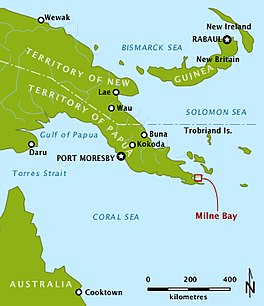| Milne Bay | |
|---|---|
 Location of Milne Bay | |
| Location | Milne Bay Province |
| Coordinates | 10°22′00″S150°30′00″E / 10.3666667°S 150.5°E |
| Type | Bay |
| Ocean/sea sources | Solomon Sea |
| Basin countries | Papua New Guinea |
| Max. length | 35 km (22 mi) |
| Max. width | 15 km (9.3 mi) |
| Surface area | 202.7 square miles (525 km2) |
| Settlements | Alotau |
Milne Bay is a large bay in Milne Bay Province, south-eastern Papua New Guinea. More than 35 kilometres (22 miles) long and over 15 kilometres (9 miles) wide, Milne Bay is a sheltered deep-water harbor accessible via Ward Hunt Strait. It is surrounded by the heavily wooded Stirling Range to the north and south, and on the northern shore, a narrow coastal strip, soggy with sago and mangrove swamps. [1] The bay is named after Sir Alexander Milne.






